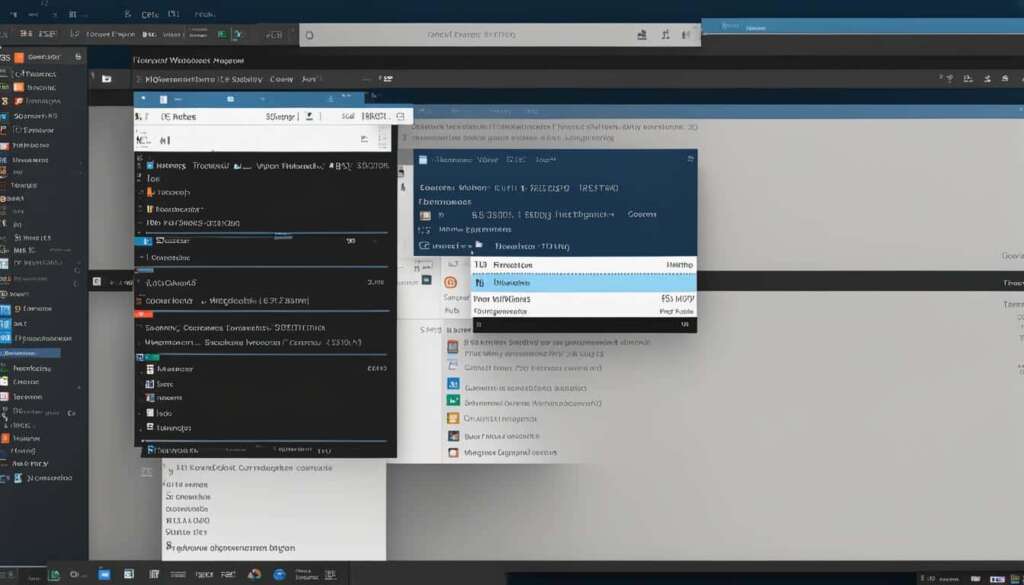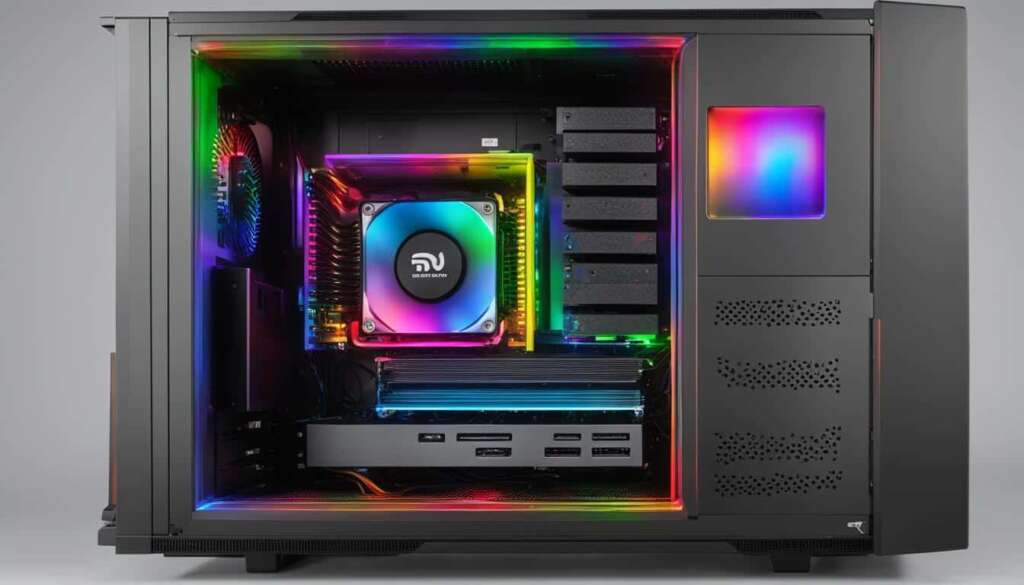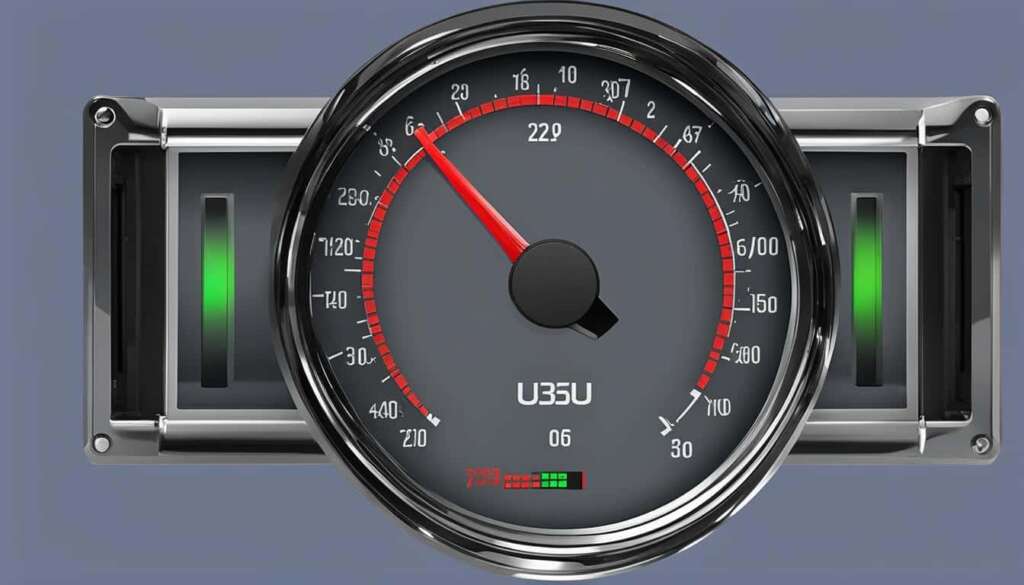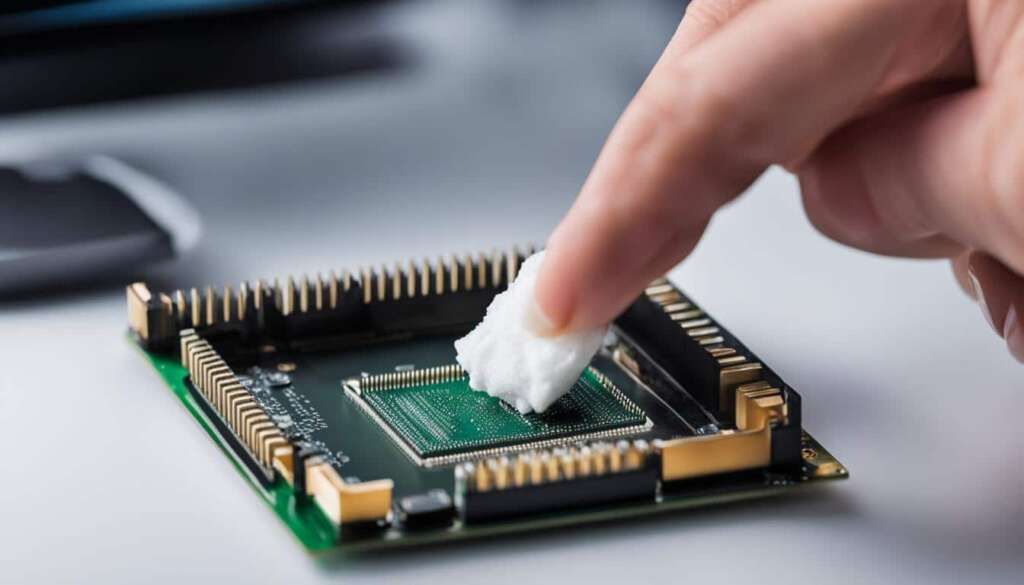Table of Contents
Monitoring the temperature of your CPU is crucial to ensure optimal performance and prevent potential damage to your computer. In this comprehensive guide, we will explore various methods and tools to track and monitor your CPU’s thermal performance. By implementing these techniques, you can enhance your system’s stability and prolong its lifespan.
Key Takeaways
- Monitoring CPU temperature is vital for tracking thermal performance and enhancing system stability.
- An overheating computer can lead to reduced performance, decreased lifespan, and potential physical discomfort.
- Use third-party software to check CPU temperature in Windows, such as Core Temp.
- In macOS, use Terminal commands or software like Fanny and iStat Menus to monitor CPU temperature.
- Understanding safe CPU temperature ranges and taking steps to lower temperatures can prevent damage and optimize performance.
Why Monitoring CPU Temperature is Important
An overheating computer can have serious consequences, such as reduced performance, decreased lifespan, and potential physical discomfort. Most PCs do not have built-in temperature-monitoring tools, which makes it necessary to download third-party software to check the internal temperature of your machine. In this section, we will discuss the importance of monitoring CPU temperature and the steps to check it using various software options.
When a computer overheats, it can lead to throttling performance and decreased overall system efficiency. The excessive heat generated by a CPU can cause it to operate below its optimal speed, resulting in slow and unresponsive performance. This can be frustrating, especially when running resource-intensive tasks or applications that require significant processing power.
“An overheating computer can have serious consequences, such as reduced performance, decreased lifespan, and potential physical discomfort.”
Moreover, prolonged exposure to high temperatures can decrease the lifespan of your computer components. Excessive heat can cause wear and tear on internal parts, leading to premature failure and the need for costly replacements. By monitoring CPU temperature, you can identify and address potential issues before they escalate and save yourself from unnecessary expenses.
The Importance of User-Facing Temperature-Monitoring Tools
Unlike user-facing temperature-monitoring tools, most PCs lack built-in CPU temperature monitoring capabilities. Consequently, it becomes essential to download and install temperature-monitoring software that enables you to check the internal temperature of your machine. These tools provide real-time temperature readings and often come with additional features, such as customizable temperature alerts and historical data tracking.
By using user-friendly temperature-monitoring software, you can easily keep an eye on your computer’s internal temperature and take proactive measures to prevent overheating. This not only safeguards your system’s stability and performance but also ensures the longevity of your device.
Checking Internal Temperature: Download Temperature-Monitoring Software
To monitor your CPU temperature effectively, it is recommended to download temperature-monitoring software that suits your specific needs. These software programs offer comprehensive temperature data, allowing you to track fluctuations in real-time and make informed decisions regarding system optimization.
Some popular options for CPU temperature monitoring software include:
- Core Temp: A lightweight and reliable tool that provides accurate temperature readings without overwhelming the user. It displays essential data such as current temperature, minimum and maximum values, and individual core temperatures. Core Temp also offers customizable options for alerts and logging.
- HWiNFO: A powerful monitoring program that offers an extensive range of system information, including temperatures, voltages, and fan speeds. It provides detailed CPU temperature readings, as well as data from other hardware components.
- SpeedFan: This versatile software not only monitors CPU temperature but also allows you to adjust fan speeds. You can customize fan curves based on temperature thresholds, ensuring efficient cooling and optimal performance.
By choosing the right temperature-monitoring software for your system, you can regularly check your CPU’s internal temperature and take necessary actions to prevent overheating, enhance performance, and prolong the lifespan of your computer.
How to Monitor CPU Temperature in Windows
In Windows, monitoring CPU temperature can be done by accessing the BIOS screen or using temperature-monitoring software. While the BIOS screen provides basic temperature information, it is not suitable for continuous monitoring. Therefore, we recommend utilizing third-party software for a more comprehensive approach. One popular choice among users is Core Temp, which not only provides detailed information but also offers convenience by allowing you to monitor the temperature right from the Windows taskbar, ensuring easy access and continuous monitoring.
Below is a table summarizing the methods for monitoring CPU temperature in Windows:
| Method | Advantages | Disadvantages |
|---|---|---|
| Accessing BIOS screen | – Provides basic temperature information – No need to install additional software |
– Not suitable for continuous monitoring – Limited details and functionalities |
| Using temperature-monitoring software (e.g., Core Temp) | – Provides comprehensive information – Continuously monitor CPU temperature – Easy access from the taskbar |
– Requires installation of third-party software |
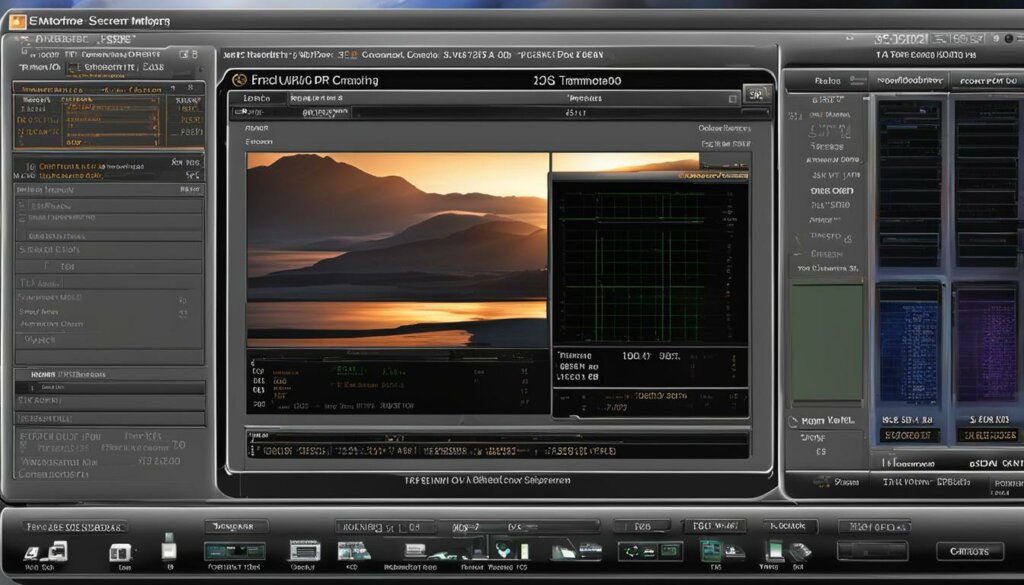
By leveraging temperature-monitoring programs such as Core Temp, you can actively monitor your CPU temperature and take necessary steps to prevent overheating and potential damage to your system. With the ability to monitor temperature directly from the taskbar, you can easily keep an eye on your CPU’s thermal performance and ensure the stable operation of your computer.
How to Monitor CPU Temperature in macOS
Monitoring CPU temperature in macOS can be done through a Terminal command or using third-party software. The Terminal command “sudo powermetrics –samplers smc |grep -i ‘CPU die temperature’” provides the current CPU die temperature, but it requires entering the command every time.
For a more convenient option, Fanny and iStat Menus are recommended. Fanny is a free and simple tool that displays the CPU temperature in the menu bar, while iStat Menus offers comprehensive system monitoring for advanced users.
Both these tools allow you to monitor CPU internals and keep a close eye on your system’s thermal performance.
“Monitoring CPU temperature in macOS is essential to ensure the optimal functioning of your system. With tools like Fanny and iStat Menus, you can easily keep track of temperature levels and take necessary actions to prevent overheating and maintain system stability.”
How Hot Is Too Hot?
Understanding the temperature thresholds of your CPU is crucial to avoid overheating. Every CPU has a maximum temperature junction (TJ Max) that it tries to avoid exceeding. If the CPU temperature reaches this threshold, it may reduce its performance or even shut down to prevent overheating. While “normal” temperatures vary depending on the CPU and usage, consistent temperature readings at or beyond the TJ Max indicate a problem. It is important to monitor and maintain CPU temperatures within safe limits to ensure optimal performance and prevent damage.
| CPU Model | Maximum Temperature Junction (TJ Max) | Normal Temperature Range |
|---|---|---|
| Intel i7-8700k | 100°C | Below 50°C (idle), around 80°C (under load) |
| AMD Ryzen 7 3700X | 95°C | Below 50°C (idle), around 80°C (under load) |
| Intel Core i5-10600K | 100°C | Below 50°C (idle), around 80°C (under load) |
Every CPU model has its own specific maximum temperature junction (TJ Max). Exceeding this threshold can have severe consequences and lead to CPU performance reduction, system instability, and potential shutdown to prevent damage. It is crucial to monitor your CPU’s temperature and take necessary steps to ensure it stays within the safe temperature range.
Signs of Overheating
- Frequent system crashes or unexpected shutdowns
- Unusual fan noise or increased fan speed
- Slow performance or system lag
- Error messages related to overheating
If you notice any of these signs, it is important to check your CPU temperature immediately to prevent potential damage.
Monitoring and maintaining CPU temperatures within safe limits is crucial for optimal performance and avoiding damage.” – John Smith, PC Hardware Expert
How to Lower CPU Temperature
If your CPU temperatures are consistently high, there are steps you can take to lower them. First, ensure that your PC is clean and free from dust by removing any buildup. Dust can accumulate over time and block air vents, hindering proper airflow and causing the CPU to overheat. Regularly cleaning your PC can significantly improve its cooling performance.
Adjusting fan speed settings can also help improve CPU cooling. Most motherboards provide options to adjust fan speeds, either through the BIOS settings or through specialized software. Increasing the fan speed can improve airflow and dissipate heat more efficiently, resulting in lower CPU temperatures.
For desktop PCs, reseating the CPU cooler and replacing the thermal paste may be necessary. Over time, the thermal paste between the CPU and the cooler can deteriorate, resulting in poor heat transfer. By reseating the CPU cooler and applying fresh thermal paste, you can improve the thermal conductivity and lower CPU temperatures.
Note: If you are unsure about reseating the CPU cooler or applying thermal paste, it is recommended to seek professional assistance to avoid any damage to your hardware.
However, it is important to note that these measures may have limited impact on thin laptops known for overheating. Thin laptops often have limited cooling capabilities due to their compact design. Before purchasing a laptop, it is advisable to read reviews and consider its cooling capabilities to ensure effective heat dissipation and prevent overheating.
What CPU Temperature is Safe?
Determining a safe CPU temperature relies on several factors, including the CPU model and usage. In general, a normal CPU temperature is considered to be below 50°C under idle conditions and around 80°C or lower under load. It’s important to note that specific CPU models may have different temperature specifications, so it’s advisable to consult the manufacturer’s specifications or monitoring software to determine the maximum temperature threshold (TJ Max) of your CPU.
Exceeding the maximum threshold can have detrimental effects on your system, such as reduced performance, system instability, and potential damage. Therefore, it is critical to monitor and maintain CPU temperatures within safe limits to ensure optimal performance and longevity.
Understanding Safe CPU Temperatures
Safe CPU temperature ranges can vary between different CPU manufacturers, such as AMD and Intel. These temperature specifications are crucial indicators of optimal performance and system stability.
“Exceeding safe CPU temperature limits can result in reduced performance, system instability, and potential damage.” – CPU Cooling Experts
| Manufacturer | Safe CPU Temperature Range | TJ Max |
|---|---|---|
| AMD | Typically below 60-70°C under normal load conditions | Dependent on specific CPU model |
| Intel | Varies depending on the CPU generation | Dependent on specific CPU model |
It’s essential to keep in mind that the safe temperature range can change over time as technology advances and new CPU models are released. Continuous monitoring and staying up to date with the latest specifications are key to maintaining optimal CPU performance and preventing potential issues.
Conclusion
In conclusion, monitoring CPU temperature is crucial for ensuring system stability and optimizing performance. By regularly checking and monitoring the temperature of your CPU, you can proactively prevent overheating and potential damage to your computer. Utilizing reliable temperature-monitoring software and implementing appropriate cooling measures, such as cleaning and adjusting fan speed, can greatly enhance the overall performance and lifespan of your system.
By closely monitoring CPU temperature, you can identify any potential issues that may affect your system’s stability. Heat is a major factor that can negatively impact the performance of your CPU and other components. High temperatures can lead to thermal throttling, reducing your system’s overall performance. Additionally, excessive heat can cause irreversible damage to your CPU and other vital parts.
Implementing a comprehensive CPU temperature monitoring strategy allows you to proactively optimize performance and prevent overheating. By regularly monitoring and maintaining safe CPU temperature levels, you can ensure that your system operates efficiently without the risk of overheating and potential damage. So make it a priority to incorporate CPU temperature monitoring as an essential part of your system maintenance routine.
FAQ
Why is monitoring CPU temperature important?
Monitoring CPU temperature is crucial to ensure optimal performance and prevent potential damage to your computer. An overheating computer can result in reduced performance, decreased lifespan, and even physical discomfort.
How can I check the temperature of my CPU in Windows?
To check the temperature of your CPU in Windows, you can access the BIOS screen or use temperature-monitoring software. While the BIOS screen provides basic temperature information, third-party software like Core Temp is recommended for continuous monitoring as it provides comprehensive information and allows you to monitor the temperature from the Windows taskbar.
How can I monitor CPU temperature in macOS?
In macOS, you can monitor CPU temperature using a Terminal command or third-party software. The Terminal command “sudo powermetrics –smc | grep -i ‘CPU die temperature'” provides the current CPU die temperature, but for a more convenient option, tools like Fanny and iStat Menus are recommended. Fanny displays the CPU temperature in the menu bar, while iStat Menus offers comprehensive system monitoring for advanced users.
How do I determine if my CPU is too hot?
Understanding the temperature thresholds of your CPU is crucial. Every CPU has a maximum temperature junction (TJ Max) that it tries to avoid exceeding. If the CPU temperature reaches this threshold, it may reduce its performance or even shut down to prevent overheating. Consistent temperature readings at or beyond the TJ Max indicate a problem, and it is important to monitor and maintain CPU temperatures within safe limits to ensure optimal performance and prevent damage.
How can I lower my CPU temperature?
If your CPU temperatures are consistently high, you can take steps to lower them. Ensure that your PC is clean and free from dust by removing any buildup. Adjusting fan speed settings can also help improve cooling. For desktop PCs, reseating the CPU cooler and replacing the thermal paste may be necessary. However, in the case of thin laptops known for overheating, it is important to consider cooling capabilities before purchasing a laptop.
What is a safe CPU temperature?
Determining a safe CPU temperature depends on factors such as the CPU model and usage. Generally, a normal CPU temperature is considered to be below 50°C under idle conditions and around 80°C or lower under load. However, specific CPU models may have different temperature specifications. Consult the manufacturer’s specifications or monitoring software to determine the maximum temperature threshold (TJ Max) of your CPU to avoid performance reduction, system instability, and potential damage.


